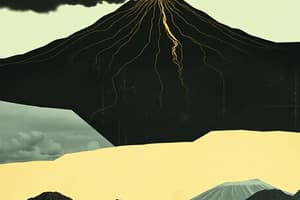Podcast
Questions and Answers
Explain the difference between basaltic, andesitic, and rhyolitic lava types in terms of viscosity, silica content, and dissolved gases.
Explain the difference between basaltic, andesitic, and rhyolitic lava types in terms of viscosity, silica content, and dissolved gases.
Basaltic lava has low viscosity, low silica content, and low dissolved gases. Andesitic lava has intermediate viscosity, intermediate silica content, and intermediate dissolved gases. Rhyolitic lava has high viscosity, high silica content, and high dissolved gases.
Describe the three main types of fault movements in earthquakes and their characteristics.
Describe the three main types of fault movements in earthquakes and their characteristics.
The three main types of fault movements in earthquakes are: Normal Fault - plates move apart and hanging wall moves down; Reverse Fault - plates press together and hanging wall moves up; Strike-Slip Fault - both plates slide past each other.
Define seismology, seismologist, seismograph, focus, and epicenter in the context of earthquakes.
Define seismology, seismologist, seismograph, focus, and epicenter in the context of earthquakes.
Seismology is the scientific study of earthquakes. Seismologist is a scientist who studies earthquakes. Seismograph is the scientific instrument that records seismic waves from an earthquake. Focus is where the earthquake slip happens below the ground. Epicenter is where the shaking is first felt above ground directly above the focus.
Explain the characteristics of P waves and S waves, including their motion and arrival sequence.
Explain the characteristics of P waves and S waves, including their motion and arrival sequence.
Flashcards are hidden until you start studying




